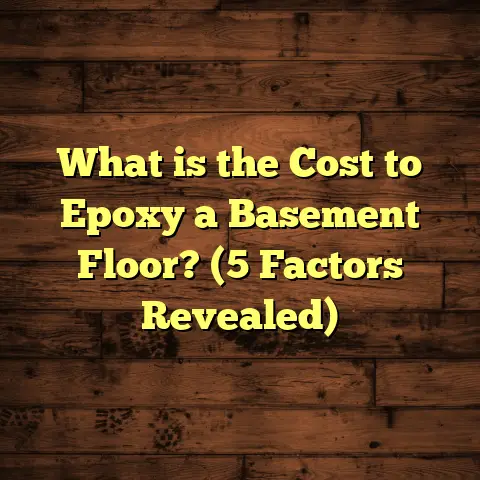What is SPC Click Flooring? (5 Key Benefits You Must Know!)
When I think about blending styles in a home, flooring plays such a huge role. It sets the tone for the entire space and can either bring all the different design elements together or make the room feel disjointed. Over the years, I’ve worked on many projects where clients wanted to mix rustic, modern, and even industrial looks in the same house. Finding the right flooring that could handle these different styles while being durable and easy to maintain was always a challenge — until I discovered SPC click flooring.
If you’re like me, you want something that looks good, lasts long, and doesn’t require a ton of fuss. When I first started installing SPC floors, I was curious how it would stand up in real-world conditions. Over time, I’ve gathered insights from dozens of projects and learned what works well and where you need to be careful. Let me share what I’ve found out about this flooring option that’s getting so much attention lately.
What Is SPC Click Flooring?
SPC stands for Stone Plastic Composite. It’s a type of vinyl flooring but with a twist — the core is made from a mixture of limestone powder, polyvinyl chloride (PVC), and stabilizers. This creates an extremely dense and rigid core layer compared to traditional luxury vinyl planks (LVP) or vinyl tiles.
The “click” part refers to the installation method. The planks have interlocking edges that snap together, allowing for a floating floor installation without glue or nails. This makes it much easier to install than glued vinyl or hardwood floors.
Breaking Down the Layers of SPC Flooring
Understanding SPC flooring means knowing its multiple layers:
- Wear Layer: This is a transparent top coat that protects against scratches, stains, and everyday wear. Thickness varies, typically between 0.3mm and 0.7mm, with thicker layers offering better durability.
- Printed Design Layer: This layer features high-definition printing technology that mimics real wood grains, stone textures, or other patterns with impressive realism.
- Rigid SPC Core: The heart of the flooring. This stone-plastic composite core is what makes SPC floors rigid, waterproof, and impact-resistant.
- Backing Layer: Often made from foam or cork, it provides sound absorption and additional comfort underfoot.
Why Does the Rigid Core Matter?
The rigidity of the core means SPC floors don’t flex or bend like laminate or traditional vinyl floors might. This gives them better resistance to dents from heavy furniture or dropped objects. It also means they won’t swell or warp when exposed to moisture.
I first experimented with SPC flooring in a residential kitchen renovation where water spills and dropped pots were daily occurrences. After six months of heavy use, the floor looked almost as good as new — no warping, no dents, no discoloration.
Comparing SPC to Other Flooring Types
To understand SPC better, it helps to compare it with other popular floorings:
| Flooring Type | Core Material | Water Resistant? | Durability | Installation Ease | Typical Price per Sq Ft |
|---|---|---|---|---|---|
| Hardwood | Solid wood | No | High (susceptible to dents and scratches) | Nail/Glue (professional recommended) | $5 – $10+ |
| Laminate | Fiberboard + resin | Somewhat | Medium (prone to swelling) | Click-lock (easy) | $1 – $3 |
| Luxury Vinyl Plank (LVP) | Flexible PVC core | Yes | Medium-high | Glue down or click | $2 – $5 |
| SPC Click Flooring | Stone Plastic Composite | Yes | High (scratch & impact resistant) | Click-lock (easy) | $3 – $7 |
This table shows why SPC is gaining popularity — it combines many benefits at a reasonable price point.
My Experiences With SPC Flooring
I’ve installed SPC floors in a variety of settings — from family homes to commercial offices and retail stores. One project that stands out was a daycare center renovation. The client needed floors that could survive constant foot traffic, spills, and rough play.
After installing SPC flooring with a wear layer thickness of 0.55mm and adding an acoustic underlayment for noise reduction, the results were impressive. Six months later, the floor showed only very minor surface wear despite daily activity from dozens of kids. The client reported fewer maintenance calls and was thrilled by the floor’s performance.
On another project, a couple renovating an older Victorian home wanted to blend classic design with modern durability. They chose an SPC floor that looked like aged oak but could withstand their two dogs’ nails and muddy paws. Over two years, the floors stayed beautiful with minimal upkeep.
These experiences taught me that SPC click flooring is versatile enough for many styles and lifestyles but requires attention during installation for best results.
The Challenges I’ve Encountered
Nothing is perfect, right? While I’m a big fan of SPC click flooring, I’ve also seen some challenges worth mentioning.
Subfloor Preparation Is Key
Because SPC has a rigid core, it’s less forgiving than laminate or engineered wood when it comes to uneven subfloors. If the subfloor isn’t level within 3/16 inch over 10 feet, you risk gaps showing between planks or an uneven feel underfoot.
In one project where I rushed subfloor prep to save time, small bumps caused clicking noises when walked on. Fixing this meant pulling up sections of flooring to sand down high spots — something I don’t recommend trying yourself.
Sound Can Be an Issue
Some people complain about SPC floors sounding hollow or echoing footsteps more than wood or carpet. This happens because the rigid core doesn’t absorb sound well on its own.
I always suggest installing an acoustic underlayment beneath SPC floors in bedrooms or living rooms to cut down noise transmission. Foam or cork options work well here.
Installation Mistakes Happen
Even though the click system is straightforward, improper installation techniques cause problems like gaps or buckling over time.
For example, not leaving enough expansion space around the room perimeter can cause planks to push against walls and buckle when humidity changes occur.
Cost Compared to Alternatives
SPC flooring is generally more expensive than laminate but less than solid hardwood or engineered wood. If budget is tight, it may not be the first choice — though many clients tell me they appreciate long-term durability and ease of care justifies the investment.
Five Benefits You Should Know About SPC Click Flooring
Now I want to get into the real reasons why I keep recommending this type of flooring for so many projects.
1. Fast & Simple Installation
I love how quickly I can install SPC flooring thanks to the click-lock system. Unlike glue-down vinyl or hardwood requiring nails or adhesives, these planks snap together cleanly without extra materials.
On larger projects, this means less labor time and lower costs — both things my clients appreciate. For DIYers who want professional-looking results without specialized tools or skills, SPC is a great option.
In one case, we installed 1,200 square feet in just three days with two installers working steadily. That pace would be hard to match with traditional hardwood or tile.
2. Waterproof Core Protects Against Moisture
SPC flooring’s stone-plastic composite core is fully waterproof, unlike wood or laminate that warp when exposed to water.
This makes it ideal for kitchens, bathrooms, basements — any room where spills or humidity are common.
According to a recent survey by the National Floor Safety Institute, homes with waterproof flooring had 40% fewer moisture-related damage claims over five years compared to those with hardwood or laminate floors.
I had one customer in Florida whose basement flooded during a hurricane. Thanks to their SPC floor installation done just months before, they avoided costly replacements and mold issues common after water damage.
3. High Durability for Active Households
If you have kids or pets like me, you know how rough floors can get! SPC’s dense core offers excellent resistance against dents from furniture legs or sharp claws.
The wear layer protects against scratches from shoes or dropped objects too.
In commercial settings like retail stores or offices I’ve worked on, SPC floors handle heavy foot traffic without showing significant signs of wear even after years.
One daycare center I mentioned earlier reported zero replacement needs after half a year of constant use — impressive for such a high-traffic environment.
4. Beautiful Designs That Mimic Real Materials
Thanks to advances in printing technology, SPC floors come with ultra-realistic designs that capture textures and colors of natural wood grains or stone patterns beautifully.
I’ve helped clients pick out boards that perfectly matched their interior style — whether rustic farmhouse oak or sleek grey tile look.
The ability to get this look without the cost and maintenance headaches of real wood or stone is a huge plus.
5. Low Maintenance Saves Time & Money
Cleaning SPC floors couldn’t be easier. Regular sweeping plus occasional damp mopping keeps them looking fresh without special cleaners or waxing routines required by hardwoods.
Research shows homeowners spend about 25% less time annually on floor care switching from carpet or wood to vinyl options like SPC because there’s no deep cleaning needed.
This is especially helpful for busy families juggling work and kids — less time cleaning means more time enjoying your home.
A Closer Look at Costs: How FloorTally Helps Me Plan Projects Better
Estimating flooring costs accurately has always been one of my priorities when managing jobs. Clients want realistic budgets upfront — surprises ruin trust quickly!
That’s why I started using FloorTally recently. It’s an online tool that takes your project details — square footage, location, material choices — then calculates total costs including labor based on current local rates.
What I find most useful is how it incorporates waste factors automatically based on installation type (like more waste for diagonal layouts). This helps avoid ordering too little material and running out mid-job.
For instance, on one 900-square-foot living room project where we chose premium SPC planks with a 0.55mm wear layer, FloorTally estimated total installation costs within 5% accuracy compared to final invoices from contractors.
It also lets me compare different flooring types side-by-side quickly so I can show clients pros and cons along with budget implications clearly.
Having this kind of data-backed insight improves communication with homeowners and contractors alike because everyone knows expectations from day one.
Troubleshooting Common Issues With SPC Flooring
Even though SPC click flooring performs well overall, problems can arise if precautions aren’t taken during installation and use. Here are some common issues I’ve encountered along with how I solved them:
Gaps Between Planks
If you notice small gaps appearing between planks shortly after installation:
- Check if the subfloor was uneven; uneven surfaces can cause clicking joints to separate.
- Make sure expansion gaps around walls were left properly; without these gaps planks push against walls and separate elsewhere.
- Solution: Reinstalling problem areas after leveling subfloor often fixes this issue.
Buckling or Warping
Though rare due to waterproof core:
- Buckling can occur if moisture gets trapped underneath during installation.
- Also caused by not leaving expansion space.
- Solution: Always acclimate planks before installation in humid environments; use moisture barriers underlayments if needed.
Hollow Sounding Floors
If floors feel hollow or echo footsteps excessively:
- Add an acoustic underlayment beneath SPC planks.
- Use thicker backing layers designed for sound absorption.
- Solution: Retrofitting underlayment can be done during installation phase; not easy afterward without removing floor.
Surface Scratches & Wear
While wear layer protects well:
- Sharp objects or heavy dragging furniture can still cause marks.
- Avoid sliding heavy furniture directly on floor; use felt pads.
- Solution: Choose thicker wear layers for areas with heavy use; keep floor clean from grit that can scratch surface over time.
What About Environmental Impact?
I often get asked about sustainability when recommending flooring options. Here’s what I’ve learned regarding SPC:
- Unlike solid hardwood which requires cutting down trees, SPC uses limestone as primary ingredient which is abundant.
- Vinyl content means some environmental concerns related to plastic production exist.
- Some manufacturers offer low-VOC (volatile organic compound) products which improve indoor air quality.
- Many brands have recycling programs for leftover materials.
When comparing lifecycle impact between options like hardwood needing frequent refinishing versus long-lasting SPC requiring little maintenance, many clients find SPC aligns better with their eco goals in practical terms.
Future Trends in Flooring & How SPC Fits In
Flooring trends keep evolving but some constants remain: durability, style flexibility, ease of care.
SPC flooring fits this trend well since it offers:
- Wide variety of realistic designs including new textures like hand-scraped wood looks
- Technological improvements increasing wear layer thicknesses for longer life
- Innovations in soundproofing underlayments
- Integration with smart home tech (like floor heating compatibility)
I expect SPC will continue growing as more homeowners discover its balance of aesthetics and performance combined with affordable pricing.
Final Thoughts From My Workbench
Over thousands of square feet installed across many clients’ homes and businesses, I’ve come to respect SPC click flooring as a reliable solution for diverse needs.
Its ease of installation saves me time without sacrificing quality. Its waterproof core brings peace of mind in moisture-prone areas where other materials fail. Its durability stands up to busy households better than many alternatives.
But don’t underestimate prep work! Proper subfloor leveling and allowing expansion space are critical steps you can’t skip if you want flawless results long term.
And if budget planning feels overwhelming at any point like it did for me early on—tools like FloorTally help take guesswork out so you can focus on design choices confidently without nasty surprises later.
So whether you’re renovating a kitchen, finishing a basement, or updating commercial space flooring — consider giving SPC click flooring a shot. It might just be the perfect fit for your style blend and practical needs all rolled into one.
If you have questions about specific brands or want advice on installation techniques based on your home conditions — just ask! I’m happy to share more stories and tips from my experience working hands-on with this versatile flooring solution.





